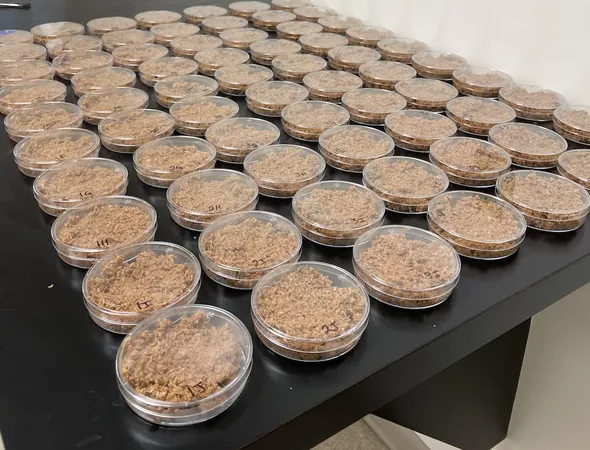
Revolutionary New Tool Unveiled to Combat Dangerous Disease-Carrying Insects!
2024-11-12
Author: Arjun
Arkansas researchers are making groundbreaking strides in the fight against disease-carrying insects by experimenting with a product traditionally used to treat pets for ticks and fleas. Their innovative approach aims to target fly and mosquito larvae, significantly reducing the spread of diseases such as malaria, dengue fever, and Zika virus.
Emily McDermott, an assistant professor of medical and veterinary entomology at the Arkansas Agricultural Experiment Station, became intrigued by the potential of fluralaner—a drug that her own dog was using after other treatments failed. McDermott highlights the drug's unique action on insect nerve cells, which disrupts their nervous systems in a way that sets it apart from conventional insecticides.
Previous studies hinted at promising results when fluralaner was used as a spray, but McDermott and her Ph.D. student, Blythe Lawson, discovered that the medication works even better when ingested. Their research focuses on delivering fluralaner directly to insect larvae, a strategy that minimizes the volume of chemicals needed and reduces environmental risks associated with widespread spraying.
The team's findings are detailed in their publication titled "Successful yeast microencapsulation of fluralaner and its potential as a larvicide for vector control," now featured in the Acta Tropica journal. Lawson emphasizes the urgent need for effective larvicides, given that only a handful are available on the market for mosquitoes, underscoring fluralaner's potential as an 'up-and-coming' synthetic chemical.
The larvae of flies and mosquitoes are notorious carriers of serious diseases, and traditional control methods often miss them by focusing on adult insects. By targeting the larvae directly, McDermott argues that public health efforts can tackle infestations before they escalate into a more significant problem.
Fluralaner is marketed under the brand name Bravecto for pet use in chewable form, but the researchers have taken it a step further. Utilizing a method akin to a "Trojan horse," they microencapsulated fluralaner in yeast, feeding it to larvae from three common species: the common house fly, the Asian tiger mosquito, and the biting midge. These larvae typically consume microorganisms like yeast, making this delivery method exceptionally effective.
Their research revealed that a single application of the microencapsulated fluralaner can remain effective for an impressive five weeks against mosquito larvae and up to eight weeks for midge larvae. This contrasts favorably with commercially available larvicides, demonstrating either equal or superior effectiveness.
Interestingly, the findings indicated that housefly larvae require a higher concentration of fluralaner for effective control compared to their mosquito and biting midge counterparts—an expected result given their larger size. However, the lower sensitivity of midge larvae was surprising.
Looking ahead, McDermott envisions the practical use of this research in everyday settings, such as around homes and waste disposal sites. The formulation process involves freeze-drying the encapsulated active ingredient into a powdered form suitable for application with standard insecticide sprayers.
With their patent-pending technology, McDermott and her team are currently collaborating with industry partners to bring this innovative larvicide to market. While there are still several steps to commercialization, the research hints at a promising new avenue for vector control and public health improvement.
The potential impact of successfully developing this yeast-based larvicide could be monumental, not only providing a powerful weapon against harmful insect populations but also safeguarding communities from the diseases they carry. Don't miss out on this incredible advancement in pest control and public health—stay tuned for updates on this groundbreaking research!

 Brasil (PT)
Brasil (PT)
 Canada (EN)
Canada (EN)
 Chile (ES)
Chile (ES)
 España (ES)
España (ES)
 France (FR)
France (FR)
 Hong Kong (EN)
Hong Kong (EN)
 Italia (IT)
Italia (IT)
 日本 (JA)
日本 (JA)
 Magyarország (HU)
Magyarország (HU)
 Norge (NO)
Norge (NO)
 Polska (PL)
Polska (PL)
 Schweiz (DE)
Schweiz (DE)
 Singapore (EN)
Singapore (EN)
 Sverige (SV)
Sverige (SV)
 Suomi (FI)
Suomi (FI)
 Türkiye (TR)
Türkiye (TR)